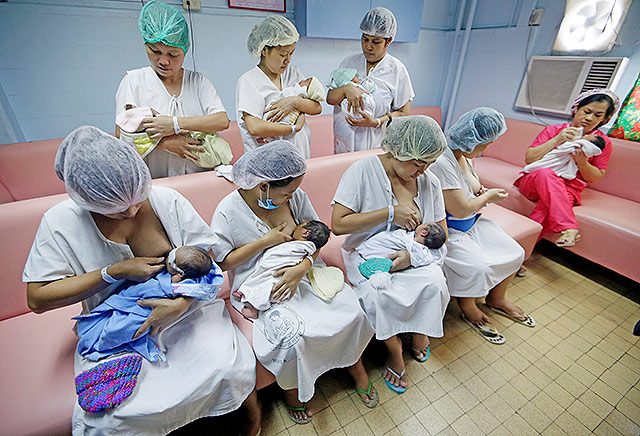SUMMARY
This is AI generated summarization, which may have errors. For context, always refer to the full article.

In our trainings, we often tell parents-to-be that breastfeeding will save them money. We try to illustrate this by using the amount we would have otherwise spent on formula multiplied to the number of months we expect to be giving milk.
However, while infant formula is considered a basic necessity, the Department of Trade and Industry (DTI) does not include it in its list of basic commodities with a recommended retail price.
The price per can, thus, varies across brands with milk companies providing a line of milk products for low, mid, and high end markets catering to infants (babies one year old and below), toddlers (1-3 years old) and even preschoolers.
For example, Nestle will have its Nestogen, Nan and Bear Brand lines. Mead Johnson has the Enfamil, Lactum, and Alacta lines. Abbott has their Gain, Similac, and Pediasure lines, while Wyeth has their S-26, Promil, and Bonna lines. A line may not just cater to differing ages but also particular conditions like picky eating, lactose intolerance, and colic. These extra special formulations also mean these milk brands will be more expensive than regular infant formula.
The price range for a 900-kilogram can of milk formula can then range from P600 ($12)* to almost P3,000 ($64).
But since there are things like socioeconomic status and preference and special conditions in the baby affecting milk purchase, let us use the World Health Organization (WHO) figure of P4,000 ($85) savings per month.
If you consider savings on a monthly basis, that amount will still help a family finance any the following:
- One to two weeks marketing/grocery allowance
- Partial or full payment for household help/nanny
- Salary for children’s tutors or payment for the school service
- Weekly dates
- Spa and shopping
- Extra money to go organic
- Partial or full payment for utility and/or insurance bills
- Vaccinations, therapy or well-baby checkups
Not bad at all right?
Now, families are encouraged to exclusively breastfeed for the first 6 months, so how about we consider the lump sum savings for that time period?
P24,000 ($513) is enough to help finance any of the following:
- A vacation
- Capital for a reselling business
- Budget for a new gadget or appliance
- Car maintenance
- Dental work
And if you breastfeed for a year, P48,000 is more than enough to fund:
- A budget trip abroad
- A baptism or birthday party
- Minor home improvements
- Partial or full school tuition
- Investments (say, mutual funds)
- Health insurance
Considering that Filipinos have adopted a culture that believes children over a year old still need milk, as evidenced by the market for follow-on formula and growing up milk, extended breastfeeding can then result in over P130,000 ($2781) savings for 3 years (assuming you spend less on milk between the 2nd and 3rd year as the child eats more solids). That’s a MacBook Pro or the beginnings of a college/retirement fund already!

I personally breastfed my first two boys for a total number of 6 years without really planning on where I will channel the savings. I was just glad that instead of buying milk, I could pay a helper to do the chores for me so I can be as hands-on with my kids as much as I wanted.
But is that really all there is to it? Can we dare to look more closely? See, cost and value are two different things. I have provided some things breastfeeding savings can be used for according to cost, but, how do we compute their value?
Being able to feed the family with the right food, made from good ingredients, increases likelihood that they will be healthier and thus sparing trips to the doctor and reducing risks for lifestyle diseases for life. There is savings in medical bills there! (READ: The real cost of infant milk formula)
Being able to pay wages means one more Filipino gets to earn and either feed their own family or support the education of their own children. How do we compute for the effect of that in reducing malnutrition, illiteracy and crime?
Being able to patronize businesses when one shops or travels mean these families contribute to the country’s trade and economy. How do we compute for its effect in our GDP?
How do we put a price on what it means to have home insurance, or new wheels on a car or even the capacity to afford therapy treatments for a special needs child? How do we quantify in pesos the worth of one’s sanity and well-being because their married life is thriving?
Incidentally, Dr Julie Smith, an Australian economist, was a guest speaker at the recently held 1st international Breastfeeding Conference in the Philippines last August 3-4, 2015 at the Crowne Plaza Hotel.
Based on a study she conducted, Dr Smith estimates that the Philippines produces human milk worth around $39.7 billion (P1.8 trillion), taking into consideration the cost of production by the mothers (which includes time and commodity costs of breastfeeding and expressing), breastfeeding initiation rates vis a vis total population and alternative market prices for valuing human milk (such as the trade cost of human milk which milk banks sell at cost to recover pasteurization and processing expenses.
In a previous interview by the Australian Breastfeeding Association, Dr Smith noted that estimating the economic importance of breastfeeding would:
- emphasize the extent of breastfeeding and its value
- acknowledge the unique contribution breastfeeding women make to society
- highlight its importance to economic welfare
- contribute to more accurate and sound economic and health policies
Taking into account the figure she has come up with, one can better appreciate how it is in the best interests of the Filipino people to further breastfeeding initiatives in the country. (READ: What’s keeping the Philippines from exclusive breastfeeding?)
Breastfeeding saves us money directly. With wisdom and prudence, it also indirectly buys us a better quality of life and creates a ripple effect that benefits others as well. It is ironic how something that is free can give us things that are priceless. It can bring positive economic impacts if supported, promoted, and protected. – Rappler.com
Mec Camitan Arevalo is a loving wife and a homeschooling mom to three boys. A mother, infant, and young child nutrition (MIYCN) advocate, Arevalo is a LATCH and Arugaan-trained breastfeeding peer counselor. She is also one of the admins of Breastfeeding Pinays.
*$1=P46
Add a comment
How does this make you feel?
There are no comments yet. Add your comment to start the conversation.